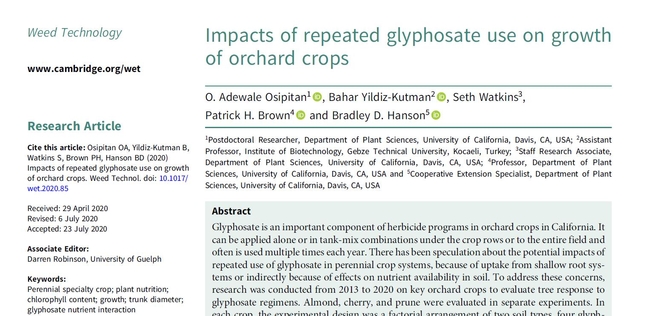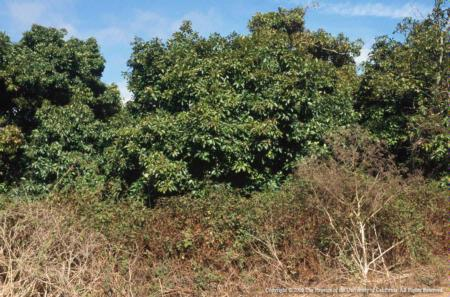Article also published in California Weed Science Society Journal (March 2021 issue)
-Brad
Glyphosate is one of the most commonly used herbicides in orchard crops in California both in terms of treated acres and amount of active ingredient applied. Weed managers are generally familiar with the attributes of glyphosate as a postemergence herbicide. Duke and Powles (2008) published an article in Pest Management Science entitled “Glyphosate: a once-in-a-century-herbicide”. Suffice to say, it's a pretty useful herbicide, if that's your thing. It has also been the subject of several controversies in the past couple of decades.
One of those controversies was a source of frequent extension questions from California farmers and Pest Control Advisors about 10 years ago. In the late 2000's there were several researcher articles from work done in glyphosate-tolerant soybeans that suggested there might be some nontarget impacts of glyphosate on crop nutrient status, plant disease interaction, and microbial community effects. In California tree crops concern generally focused around whether glyphosate in the soil could chelate micronutrients and lead to nutrient deficiencies and/or if repeated use could cause enough glyphosate to accumulate in soil and have direct impacts on the trees.
In a 2012 review article on the impacts of glyphosate in the soil environment, Duke et al. suggested that “significant effects of glyphosate on soil mineral content is unlikely” and there is no clear negative trend in orchard productivity data in California even after decades of glyphosate use. However, because this was a concern for the California orchard crop industries, we conducted a long-term research project from 2013 to 2020 to help address the issue in representative orchard crops.
If you're REALLY interested, the full report was published in summer 2020 as an open-access article in the journal Weed Technology which can be accessed HERE.
If you're only a LITTLE interested, here is the essence of the project conduct at the UC Davis Plant Sciences Field Facility in Davis, CA:
- Crops (three crops were considered separate experiments):
- Almond (Nonpareil on Lovell)
- Prune (Improved French on Lovell)
- Cherry (Coral on Emla-Colt)
- Planting site:
- At planting, all tree sites were excavated with a 36-inch diameter augur to a 2-ft depth
- Half were refilled with the native silty clay loam soil
- Half were refilled with Delhi sandy loam
- Glyphosate treatments:
- From 2014 to 2019, treatments were applied 3 times per season (~between Apr-Nov)
- Rates were 0, 1, 2, or 4 lb ae/A equivalents (Roundup PowerMAX plus ammonium sulfate). Applied to an area of about 6x6 ft around each tree
- In 2014, trunks were protected with cartons, but no trunk protection in 2015-19
- Drench
- In the first two years of treatment (2014 and 2015) there was a split-plot factor in which half of the trees had a small berm built up around the base of the tree and were “drenched” with water to simulate a 1-inch irrigation immediately after each application (intended to increase leaching into the relatively small tree root zone and crown area).
- Evaluations
- In the first year of treatment (2014) leaf samples were collected 14 days after each glyphosate application and assayed for shikimate accumulation (which would indicate direct herbicidal effects of glyphosate).
- In the first two years of treatment, relative chlorophyll content was measured in leaves from each tree 30 days after each glyphosate application (which could indicate either direct glyphosate effects or indirect effects of micronutrient limitations).
- Trunk diameter measurements were made before the first application in 2014 and during the winter after each subsequent season to evaluate relative tree growth.
- After the 6th year of treatment, leaf samples were collected in the fall from each tree but combined over soil type and drench subplots. The nutrient status of these leaf samples was determined by the UC Davis Analytical Lab using appropriate techniques.
- So, to recap, the worst case scenario had:
- Very coarse soil in the planting site of bare root almond, cherry, and prune nursery trees.
- In the first two years, some plots had a simulated acre-inch of irrigation immediately following each glyphosate application.
- The highest rate treatment of 4 lb ae/A glyphosate applied 18 times over a six year period. That's 114 fl oz/A of Roundup PowerMAX at each application. Over the course of the experiment that's 72 lb ae/A glyphosate or 16 gallons of Roundup PowerMAX. It's a lot!
- Results:
- Shikimate levels were similar among treated and non-treated trees with no clear dose-response or soil-related parameters. This suggests little or no direct effect of glyphosate on these tree crops via root uptake even at fairly extreme rates over multiple years.
- Chlorophyll content mostly indicated no differences among treatments. Where there were statistically significant main effects or interactions, there was no consistent pattern with regard to glyphosate rate, coarse soils, and post-treatment drench, which suggests they may be due to random variation or experimental artifacts.
- Leaf nutrient analysis after 6 years of treatment did not provide evidence of negative impacts on crop nutrient status.
- Trunk diameter increase over six growing seasons was not negatively impacted by glyphosate treatments (Figure).
- Observationally, over the six year period, there was no evidence of treatment-related trunk cankers, trunk or limb malformations or unusual die-back.
Scientists will always remind you that you “can't prove a negative”, and that remains true. However, we think these data suggest that it is probably not easy or common for almond, cherry, or prunes to be negatively impacted by glyphosate residues in the soil either due to direct herbicide effects or to micronutrient deficiencies.
Acknowledgments:
This work was initially supported by the Almond Board of California, the California Dried Plum Board and with nursery stock provided by Sierra Gold Nurseries. Over time, the experiments were maintained with general program support from the crop protection industry, orchard commodity groups, and agricultural input suppliers. We gratefully thank our colleagues who contributed to this long-term project along the way.
References:
Duke SO, Powles SB (2008) Mini-review. Glyphosate: a once-in-a-century herbicide. Pest Manag Sci 64:319–325
Duke SO, Lydon J, Koskinen WC, Moorman TB, Chaney RL, Hammerschmidt R (2012) Glyphosate effects on plant mineral nutrition, crop rhizosphere microbiota, and plant disease in glyphosate-resistant crops. J Agric Food Chem 60:10375–10397
Osipitan OA, Yildiz-Kutman B, Watkins S, Brown PH, Hanson BD (2020). Impacts of repeated glyphosate use on growth of orchard crops. Weed Technol. doi: 10.1017/wet.2020.85 (available at: https://www.cambridge.org/core/journals/weed-technology/article/impacts-of-repeated-glyphosate-use-on-growth-of-orchard-crops/26697F334626A587765C75C2B0F76A3D)
This blog originally appeard in the UC Weed Science Blog
https://ucanr.edu/blogs/blogcore/postdetail.cfm?postnum=46316
Attached Images:

